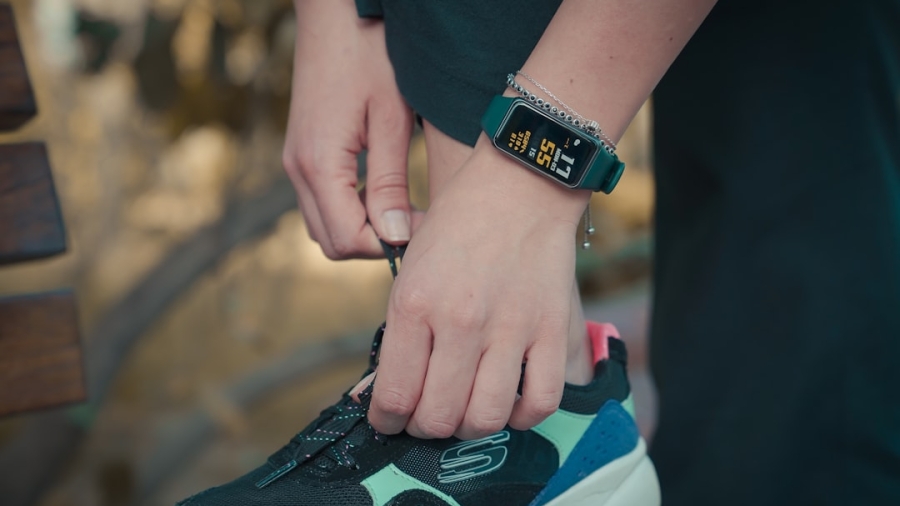In recent years, the rise of wearable technology has transformed the way individuals monitor their health and fitness. Among these innovations, smart rings have emerged as a compact and stylish alternative to traditional fitness trackers and smartwatches. These small, unobtrusive devices are designed to be worn on the finger, offering a range of functionalities that cater to both fitness enthusiasts and those seeking to enhance their overall well-being.
Smart rings combine advanced technology with sleek design, making them an appealing choice for users who prefer a more subtle approach to health monitoring. As the demand for personal health data continues to grow, smart rings have carved out a niche in the wearable tech market, providing users with valuable insights into their daily activities and physiological states. The appeal of smart rings lies not only in their functionality but also in their versatility.
Unlike bulkier devices, these rings can be worn throughout the day without drawing attention, making them suitable for various settings—from the gym to the office. Many models are crafted from durable materials such as titanium or ceramic, ensuring they can withstand daily wear and tear while maintaining an elegant appearance. As technology continues to advance, smart rings are becoming increasingly sophisticated, integrating features that were once exclusive to larger devices.
This evolution reflects a broader trend in the tech industry toward miniaturization and user-friendly design, allowing individuals to seamlessly incorporate health monitoring into their everyday lives.
Key Takeaways
- Smart rings are wearable devices that offer fitness and wellness tracking features in a compact and stylish form.
- The technology behind smart rings includes sensors for tracking activity, heart rate, sleep patterns, and more, as well as connectivity to smartphones for data analysis.
- Fitness tracking features of smart rings include step counting, distance tracking, calorie monitoring, and workout intensity measurement.
- Wellness monitoring features of smart rings include heart rate monitoring, sleep tracking, stress level detection, and hydration reminders.
- Using smart rings in fitness and wellness can provide benefits such as improved motivation, better understanding of health metrics, and personalized insights for achieving wellness goals.
Technology Behind Smart Rings
Advanced Sensors and Technologies
At the core of every smart ring lies a sophisticated array of sensors and technologies that enable it to collect and analyze data. Most smart rings are equipped with sensors that monitor various physiological parameters, such as heart rate, body temperature, and sleep patterns. These sensors work in conjunction with advanced algorithms that process the collected data, providing users with actionable insights into their health and fitness levels.
Physiological Monitoring and Miniaturized Technology
For instance, optical sensors use light to measure blood flow beneath the skin, allowing the ring to calculate heart rate and estimate oxygen saturation levels. This technology is similar to that found in more prominent wearables but is ingeniously miniaturized to fit within the confines of a ring. This miniaturization showcases the innovative engineering that goes into creating smart rings.
Connectivity and Multifunctionality
In addition to physiological monitoring, many smart rings utilize Bluetooth technology to connect with smartphones and other devices. This connectivity allows users to sync their data with dedicated apps, where they can track their progress over time and receive personalized recommendations based on their activity levels and health metrics. Some smart rings also incorporate NFC (Near Field Communication) technology, enabling contactless payments and other convenient features.
Fitness Tracking Features

One of the primary functions of smart rings is fitness tracking, which has become increasingly important in today’s health-conscious society. Many smart rings come equipped with features that allow users to monitor their physical activity throughout the day. This includes tracking steps taken, distance traveled, and calories burned, providing a comprehensive overview of one’s daily movement.
Some advanced models even offer workout recognition capabilities, automatically detecting when users engage in specific activities such as running or cycling. This level of detail helps individuals set realistic fitness goals and stay motivated as they work towards achieving them. Moreover, smart rings often provide insights into workout intensity and recovery times, which are crucial for optimizing training regimens.
By analyzing heart rate variability during exercise, these devices can help users understand when they are pushing themselves too hard or when they need additional rest. This feedback is invaluable for athletes and fitness enthusiasts alike, as it allows them to tailor their workouts for maximum effectiveness while minimizing the risk of injury. With the ability to track progress over time, users can make informed decisions about their fitness journeys, adjusting their routines based on real-time data.
Wellness Monitoring Features
Beyond fitness tracking, smart rings also play a significant role in wellness monitoring, addressing various aspects of an individual’s health that contribute to overall well-being. Many models include features that track sleep quality and duration, providing insights into sleep patterns that can help users improve their rest. By analyzing factors such as heart rate variability and movement during sleep, smart rings can offer personalized recommendations for enhancing sleep hygiene.
This is particularly important in today’s fast-paced world, where many individuals struggle with sleep-related issues due to stress or irregular schedules. Additionally, some smart rings are equipped with stress monitoring capabilities that assess physiological responses to stressors throughout the day. By measuring changes in heart rate or skin temperature, these devices can alert users when they may be experiencing heightened stress levels.
This feature encourages mindfulness and self-awareness, prompting users to engage in relaxation techniques or take breaks when needed. The integration of wellness monitoring features into smart rings underscores their role as holistic health tools that support not only physical fitness but also mental and emotional well-being.
Benefits of Using Smart Rings in Fitness and Wellness
The benefits of incorporating smart rings into one’s fitness and wellness routine are manifold. Firstly, their compact design makes them incredibly convenient for everyday use. Unlike larger wearables that may feel cumbersome during workouts or daily activities, smart rings are lightweight and unobtrusive, allowing users to wear them continuously without discomfort.
This constant wear enables more accurate data collection over time, leading to better insights into long-term health trends rather than just short-term snapshots. Moreover, the data provided by smart rings can empower users to take control of their health in ways that were previously unattainable. With real-time feedback on physical activity levels, sleep quality, and stress responses, individuals can make informed decisions about their lifestyle choices.
This proactive approach fosters a greater sense of accountability and motivation as users see tangible results from their efforts. Additionally, many smart ring apps offer community features that allow users to connect with others on similar wellness journeys, creating a supportive environment that encourages shared goals and achievements.
Comparison of Different Smart Rings on the Market

Unique Features for Specific Needs
Some popular models include the Oura Ring, Motiv Ring, and Go2Sleep Ring, each offering unique features that cater to specific user requirements. The Oura Ring is renowned for its comprehensive sleep tracking capabilities and detailed recovery insights, making it a favorite among those focused on optimizing their rest and recovery periods.
Design and User Experience
Its sleek design and user-friendly app interface further enhance its appeal. On the other hand, the Motiv Ring emphasizes fitness tracking with its robust activity monitoring features while still providing essential wellness metrics like sleep analysis. Its lightweight design makes it suitable for all-day wear without compromising comfort or style.
Comparing Models for Informed Decisions
The Go2Sleep Ring stands out for its focus on sleep apnea detection and respiratory monitoring, appealing particularly to individuals concerned about sleep-related health issues. By comparing these models based on features such as battery life, app functionality, and price points, consumers can make informed decisions that align with their personal health goals.
Tips for Using Smart Rings Effectively
To maximize the benefits of using a smart ring, users should consider several practical tips that enhance their experience with these devices. First and foremost, it is essential to wear the ring consistently for accurate data collection. While it may be tempting to remove the ring during certain activities or while sleeping, doing so can lead to gaps in data that hinder overall insights into health trends.
Establishing a routine where the ring is worn at all times will ensure comprehensive tracking of both fitness and wellness metrics. Additionally, users should take advantage of the accompanying mobile apps that often come with smart rings. These apps typically provide detailed analytics and personalized recommendations based on collected data.
Engaging with these insights can help users identify patterns in their behavior—such as how sleep quality affects daily performance or how physical activity influences mood—allowing them to make informed adjustments to their routines. Regularly reviewing this data not only fosters accountability but also encourages users to celebrate milestones along their wellness journey.
Future Developments in Smart Ring Technology
The future of smart ring technology holds exciting possibilities as advancements in materials science and sensor technology continue to evolve. One area of potential growth is the integration of additional health metrics into smart rings. For instance, future models may include sensors capable of monitoring blood glucose levels or hydration status—features that would significantly enhance their utility for individuals managing chronic conditions or those seeking more comprehensive health insights.
Moreover, as artificial intelligence (AI) becomes increasingly sophisticated, we may see smart rings equipped with predictive analytics capabilities that can forecast potential health issues before they arise. By analyzing historical data trends alongside real-time metrics, these devices could provide early warnings about potential health risks or suggest proactive measures for maintaining optimal wellness. As manufacturers continue to innovate and refine their designs, smart rings are poised to become even more integral components of personal health management systems in the years ahead.
If you’re interested in how technology can enhance your fitness and wellness routines, you might also want to explore the best devices to support your health goals. For instance, choosing the right gadgets can make a significant difference in how effectively you integrate technology with daily health management. A related read that could be beneficial is about selecting your child’s first tablet, which not only discusses educational and entertainment aspects but also touches on apps and features that can promote a healthy, active lifestyle for children. You can read more about it here.
FAQs
What is a smart ring?
A smart ring is a wearable device that is worn on the finger and is equipped with technology to track various health and fitness metrics.
How do smart rings work in fitness and wellness?
Smart rings work in fitness and wellness by using sensors to track metrics such as heart rate, sleep patterns, activity levels, and more. They then sync this data to a smartphone app for users to monitor and analyze their health and fitness.
What are the benefits of using a smart ring for fitness and wellness?
Some benefits of using a smart ring for fitness and wellness include the ability to track and monitor health metrics in real-time, set and achieve fitness goals, and gain insights into overall health and well-being.
What features do smart rings typically have for fitness and wellness?
Smart rings for fitness and wellness typically have features such as heart rate monitoring, sleep tracking, activity tracking, calorie counting, and stress management tools.
Are smart rings accurate for tracking fitness and wellness metrics?
The accuracy of smart rings for tracking fitness and wellness metrics can vary depending on the specific device and its sensors. It’s important to research and choose a reputable smart ring with accurate tracking capabilities.

